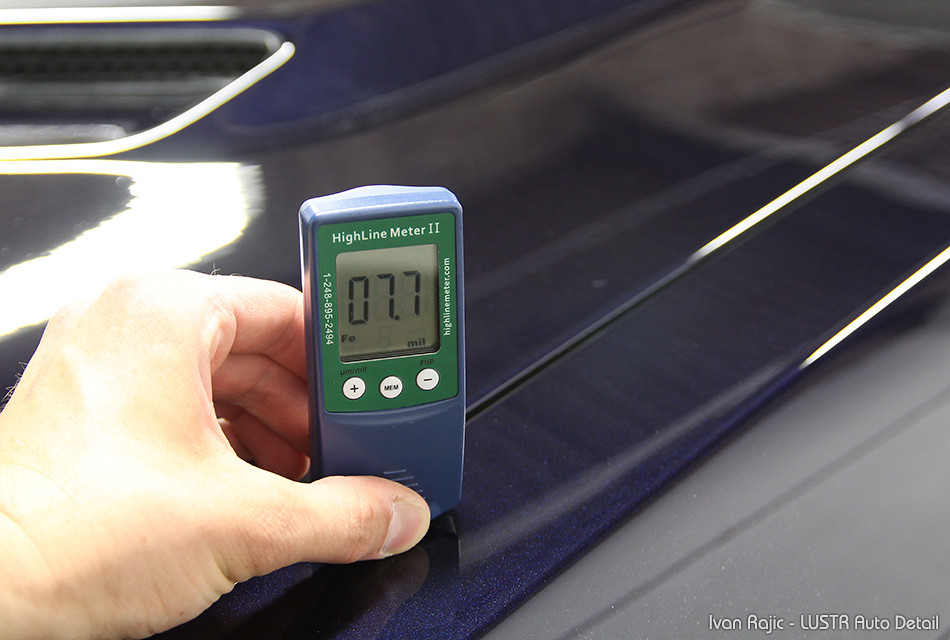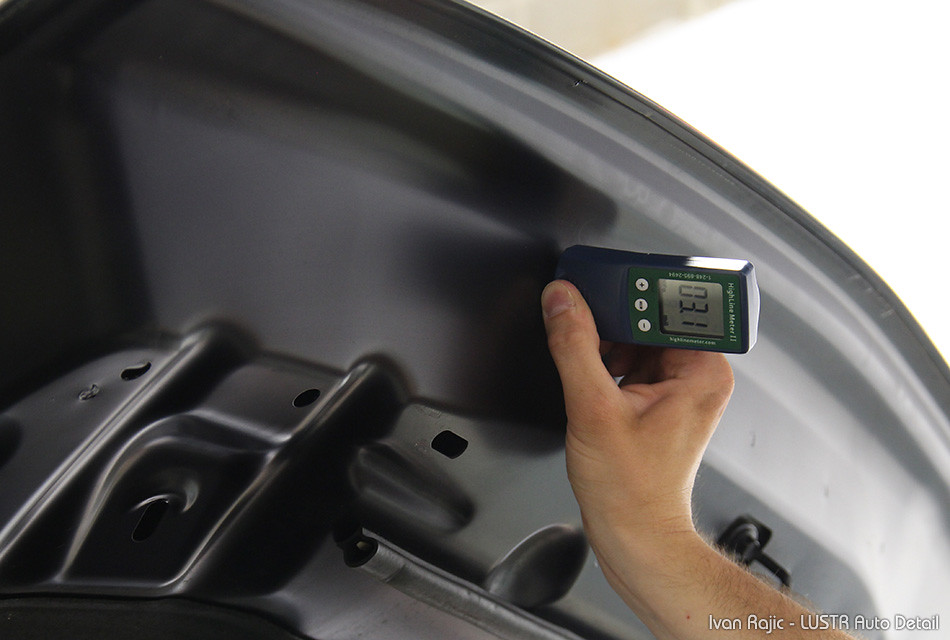Paint Measurements & What They Mean
by Ivan RajicWe hear about this all the time, but many people are still clueless as to what it all means. Paint measurements are taken by most professionals in order to determine the thickness of paint and how much polishing/correction is safe. It’s also a great tool both for professionals and individuals to simply inspect vehicles before purchase to find any hidden body work or repainted areas. While there are normally anomalies in paint measurements even on a brand new vehicle, ranging +/- 1 Mil, measurements on repainted areas will normally give a much higher reading that indicates something was previously done.
I have had my HighLine Meter Paint Thickness Gauge for well over 3 years now and use it almost on a daily basis. We use it mainly when doing more than a 2-stage paint correction, especially on older vehicles that have a suspect paint job. However, we also use it on almost every car to simply do a thorough inspection and make sure we can report to the client if there are any panels that may be the odd one out. Since the thickness normally varies on a car, even only an inch from one another, we tend to mainly use Mils instead of Microns only to find any large differences in paint thickness. For reference, Mils are 1/1000th of an inch and Microns are 1/1000th of a millimeter, so the Mil is much larger of a measurement, 25.4 times larger than the Micron to be exact.
The main thing to mention about this gauge, and most others similar to it, is that it only measures paint as one layer. This means that on a newer car it measures the thickness of the primer, base coat and clear coat as one. This can be deceiving because we’re only working with clear coat, which means we need the measurement for that and could care less about the amount of primer or base coat on the car. There are standards out there of how much primer and base coat is normally on the car, which is anywhere from 1.0-2.2 Mils from our findings, but there are sometimes ways to make a more educated guess for the clear coat thickness. We do this by taking the measurement of the whole thickness of paint on various panels, in this case hood…

Then we take measurements of jambs as they many times have very little to no clear coat…

In this case we found the readings under the hood to be at around 3.0 Mils, which means either it’s thicker than normal for primer + base or it simply has a light layer of clear coat. The readings of all layers was averaging around 7.5, so we can safely assume there’s plenty of paint/clear coat to work with.
Now, the reason I say it’s safe is basically because from researching (paint manufacturers, reputable detailers and car manufacturers) I have found that clear coat should be a minimum of around 2.0 Mils to stay in tact. This means if you’re getting a reading of 1.5 below the hood and 3.5 on top, it’s highly likely you may degrade the clearcoat by doing some heavy polishing. By heavy polishing, I mean using a compound and a cutting pad, such as M105 and Purple Foamed Wool, but this can vary depending on the sensitivity of the paint. Some very hard clear coats can withstand a heavy polishing a lot better than other paints, so one needs to be aware of the situation. Lastly, we have found average paint jobs to be anywhere from 4.0 to upper 4s or 5.0 Mils, depending on the make, model, etc. In all my years of detailing, I’ve seen some OEM paint that’s as low as 3.5 Mils or so and then others upwards of 8-9. The thicker ones are usually higher end cars, like Bentley, Ferrari, etc.
There are expensive gauges available that read multiple layers of paint, but for typical polishing work and DIY inspections, the HighLine Meter Paint Thickness Gauge is a great tool that gives more than enough information. Hopefully this gives a better insight to the world of paint measurements and utilizing the gauge to inspect paint in general!










Hi Ivan
I am considering purchasing one of the HighLine meters. Reading the specs on the 2 meters they appear basically the same. I am a hobbiest detailer and would like to know which of the 2 are the best bang for the buck.
Thank you
Greg, I’ve never owned the 1st gen gauge, but have heard great things about it and purchased the 2nd gen based on that as it was out at the time. I would have to say the 1st gen is completely fine for a hobbiest detailer and the biggest difference (maybe only differences) in the 2nd gen is the nicer shape (I guess that’s subjective), 1 battery only vs 4 and the flip screen. In short, you can’t go wrong with the 1st gen, but 2nd gen does have a few things that are better and may make it worth it the 20% price increase.
Ivan,
Can you give us any rough idea of the amount of clear removal expected from heavy compounding, light polishing, etc? I know this is a very broad question, dependent on many factors, but it would be helpful to have a ballpark number to know what to expect.
Thanks for the info!
Jordan that is surely an extremely general question that I honestly can’t answer. Heavy compounding for some can mean using some “rocks in a bottle” polish on a wool pad with a rotary polisher. For others, it means an orange Lake Country pad with Meguiar’s 105, so obviously they can provide very different levels of cut. In addition, the paint is a huge variable so it’s very hard to simply say you remove 2 microns or something like that. Again, I wish I could tell you an exact number, but for the reasons mentioned above I can’t nor have I ever measured too precisely. I’m sure it’ll pop up as an article in the future :).
Thank you so much for working this topic! Great information!!
Two things:
1) A follow-up article (or even a series) on detailing older cars seems to be a natural from this article. Granted, that opens the doors on a lot of variables, but even if it could be covered on such points as detailing the differing paints and finishes found as original over the last 5 or 6 six decades, would be insightful.
2) If you have any insights you could share as to what thinknesses and hardnesses the different vehicle makes have, would be helpful. (As an example, I see a number of Honda models where I can only assume the previous owners used brush car washes. The clearcoat seems to be gone from elevated surfaces and edges. That makes me wonder if on those where the finish appears workable, if in fact they may be a few detailings away from problems.) This is where your article and the gauge would be very helpful.
Thanks again,
RC
Thanks Richard, I’ll surely make note of that and keep in mind for the near future.
Very helpful article, thank you Ivan.
Do you know the thickness of a Land Rover Discovery 4 2010 paint?
Rafael, I’ve never measured one of those, but even if I did it could vary from car to car unfortunately.
Hi Ivan I’m debating between this paint guage vs the 2700.00 model DI sells. I correct cars daily which includes wetsanding. I know I need a guage but 27 hurts. Im afraid this meter doesnt give me anything more than an educated guess (thickness of clear coat) What do you suggest?
Eric to some extent you’re right. This tool is by no means as good and accurate as the DeFelsko PosiTector 200, but it’s also not worthless. We use it for all correction work in order to make sure there’s enough clearcoat to work with and also to check areas for repaint, etc. Since it measures only the overall thickness, you will only know roughly how much clear coat there is on the car, but it’s definitely better than nothing and a great guide.
Very helpful and thank you for posing this article. Nowadays all the car companies are using a thin layer of paints on the metal, but by using it, we can inspect the vehicle before purchasing it. Many people still don’t understand what is its use; for them, it is a worth reading article.